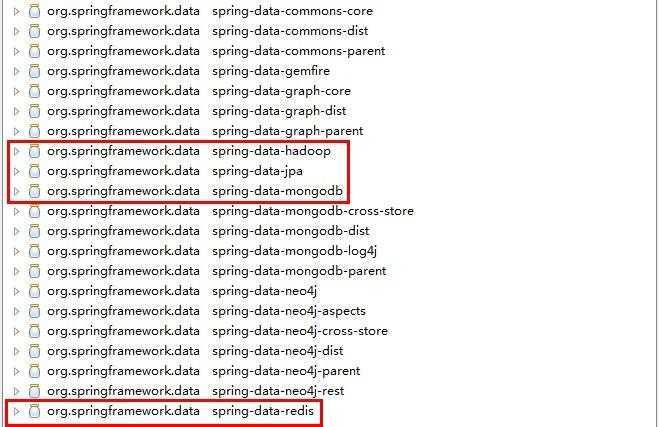标签:des style blog http color os io 使用 java
Spring提供了对于Redis的专门支持:spring-data-redis。此外,类似的还有:

我想大部分人对spring-data-hadoop、spring-data-mongodb、spring-data-redis以及spring-data-jpa表示关注。
一、简述
spring把专门的数据操作独立封装在spring-data系列中,spring-data-redis自然是针对Redis的独立封装了。
当前版本1.0.1,主要是将jedis、jredis、rjc以及srp等Redis Client进行了封装,同时支持事务。已经让我垂涎欲滴了。当然,当前版本不支持Sharding。例如,前文曾经通过Jedis通过Client配置,实现一致性哈希,达到Sharding的目的。再一点,如果你早在spring1.x写过SpringJdbc的话,现在会觉得似曾相识。
在经过一番思想斗争后,我最终放弃了Jedis原生实现,拥抱spring-data-redis了。为什么?因为,我需要一个有事务机制的框架,一个不需要显式调用对象池操作的框架。这些spring-data-redis都解决了。至于Sharding,当前数据量要求还不大,期待Redis 3.0吧。
二、配置
对象池配置:
<bean id="jedisPoolConfig" class="redis.clients.jedis.JedisPoolConfig">
<property name="maxActive" value="${redis.pool.maxActive}" />
<property name="maxIdle" value="${redis.pool.maxIdle}" />
<property name="maxWait" value="${redis.pool.maxWait}" />
<property name="testOnBorrow" value="${redis.pool.testOnBorrow}" />
</bean>
工厂实现:
<bean id="jedisConnectionFactory" class="org.springframework.data.redis.connection.jedis.JedisConnectionFactory">
<property name="hostName" value="${redis.ip}" />
<property name="port" value="${redis.port}" />
<property name="poolConfig" ref="jedisPoolConfig" />
</bean>
模板类:
<bean class="org.springframework.data.redis.core.RedisTemplate"
p:connection-factory-ref="jedisConnectionFactory" />
是不是很像配置一个JdbcTemplate?其实就这么简单。
redis.properties配置如下:
#最大分配的对象数
redis.pool.maxActive=1024
#最大能够保持idel状态的对象数
redis.pool.maxIdle=200
#当池内没有返回对象时,最大等待时间
redis.pool.maxWait=1000
#当调用borrow Object方法时,是否进行有效性检查
redis.pool.testOnBorrow=true
#IP
redis.ip=10.11.20.140
#Port
redis.port=6379
当前只能用一个节点,期待Redis 3.0,Sharding吧
三、GET、SET、DEL操作
Redis初来乍练,目前也就是用Memcached多些,只会这些基本的操作,在这里献丑了
假定做一个UserDao:
public interface UserDao {
/**
* @param uid
* @param address
*/
void save(User user);
/**
* @param uid
* @return
*/
User read(String uid);
/**
* @param uid
*/
void delete(String uid);
}
User对象就这么两个属性:
public class User implements Serializable {
private static final long serialVersionUID = -1267719235225203410L;
private String uid;
private String address;
}
实现这三个方法需要得到RedisTemplate的支持:
@Autowired
private RedisTemplate<Serializable, Serializable> redisTemplate;
为什么用序列化泛型?我存的数据都是可序列化的内容。还有更多为什么?其实我也解答不了很多,边练边学,我弄通了一定告诉你
1. 保存-SET
做一个保存造作,使用Redis的SET命令:
@Override
public void save(final User user) {
redisTemplate.execute(new RedisCallback<Object>() {
@Override
public Object doInRedis(RedisConnection connection)
throws DataAccessException {
connection.set(
redisTemplate.getStringSerializer().serialize(
"user.uid." + user.getUid()),
redisTemplate.getStringSerializer().serialize(
user.getAddress()));
return null;
}
});
}
这里是通过模板类,实现方法回调。在spring框架下,可以方便的控制事务,如果你研究过spring的dao源代码,对此一定熟悉。
1. 传入参数,需要final标识,禁止方法内修改。
2. 调用RedisConnection的set方法实现Redis的SET命令。
3. 不管是Key,还是Value都需要进行Serialize。
4. 序列化操作,最好使用RedisTemplate提供的Serializer来完成。
这跟当年的SpringJdbcTemplate有那么一拼
2. 获取-GET
想要将对象从Redis中取出来,就麻烦一些,需要序列化key,最好判断下这个key是否存在,避免无用功。如果键值存在,需要对数据反序列化。
@Override
public User read(final String uid) {
return redisTemplate.execute(new RedisCallback<User>() {
@Override
public User doInRedis(RedisConnection connection)
throws DataAccessException {
byte[] key = redisTemplate.getStringSerializer().serialize(
"user.uid." + uid);
if (connection.exists(key)) {
byte[] value = connection.get(key);
String address = redisTemplate.getStringSerializer()
.deserialize(value);
User user = new User();
user.setAddress(address);
user.setUid(uid);
return user;
}
return null;
}
});
}
当年写SpringJdbc的时候,就是这样一个字段一个字段拼装的,甭提多累人。好吧,用Spring-Data-Redis,又让我回归了
1. 记得使用泛型,如RedisCallback<User>()
2. 使用同一的序列化/反序列化Serializer
3. 建议使用connection.exists(key)判别键值是否存在,避免无用功
3. 删除-DEL
删除,就简单点,不过也需要这样折腾一会:
@Override
public void delete(final String uid) {
redisTemplate.execute(new RedisCallback<Object>() {
public Object doInRedis(RedisConnection connection) {
connection.del(redisTemplate.getStringSerializer().serialize(
"user.uid." + uid));
return null;
}
});
}
做个TestCase,暂时够我用了
4. TestCase
import static org.junit.Assert.*;
import org.junit.Before;
import org.junit.Test;
import org.springframework.context.ApplicationContext;
import org.springframework.context.support.ClassPathXmlApplicationContext;
import org.zlex.redis.dao.UserDao;
import org.zlex.redis.domain.User;
public class UserDaoTest {
private ApplicationContext app;
private UserDao userDao;
@Before
public void before() throws Exception {
app = new ClassPathXmlApplicationContext("applicationContext.xml");
userDao = (UserDao) app.getBean("userDao");
}
@Test
public void crud() {
// -------------- Create ---------------
String uid = "u123456";
String address1 = "上海";
User user = new User();
user.setAddress(address1);
user.setUid(uid);
userDao.save(user);
// ---------------Read ---------------
user = userDao.read(uid);
assertEquals(address1, user.getAddress());
// --------------Update ------------
String address2 = "北京";
user.setAddress(address2);
userDao.save(user);
user = userDao.read(uid);
assertEquals(address2, user.getAddress());
// --------------Delete ------------
userDao.delete(uid);
user = userDao.read(uid);
assertNull(user);
}
}
貌似少了update,也许以后操作Hash时,会用上。
看看控制台获得了什么:
redis 127.0.0.1:6379> get user.uid.u123456
(nil)
redis 127.0.0.1:6379> get user.uid.u123456
"\xe5\x8c\x97\xe4\xba\xac"
redis 127.0.0.1:6379> get user.uid.u123456
"\xe4\xb8\x8a\xe6\xb5\xb7"
redis 127.0.0.1:6379> del user.uid.u123456
(integer) 1
redis 127.0.0.1:6379> get user.uid.u123456
(nil)
redis 127.0.0.1:6379> get user.uid.u123456
"\xe4\xb8\x8a\xe6\xb5\xb7"
好吧,可以开始用它来存点什么了
本文转载自:http://www.zhangsr.com/cms/blog/viewUserBlog.action?blogId=528
征服 Redis + Jedis + Spring —— 配置&常规操作
标签:des style blog http color os io 使用 java
原文地址:http://www.cnblogs.com/hqbhonker/p/3953143.html